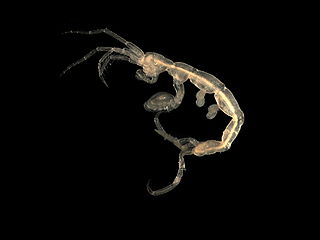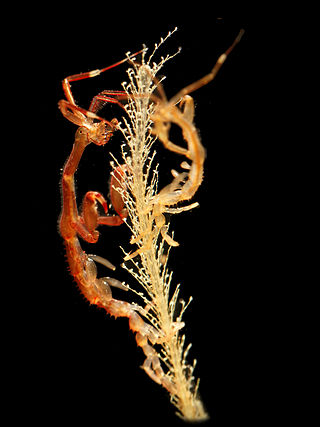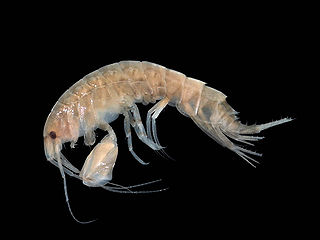| Sinocorophium | |
|---|---|
 | |
| Sinocorophium hangangense | |
| Scientific classification | |
| Kingdom: | |
| Phylum: | |
| Subphylum: | |
| Class: | |
| Order: | |
| Family: | |
| Genus: | Sinocorophium Bousfield & Hoover, 1997 |
Sinocorophium is a genus of amphipod crustaceans.
| Sinocorophium | |
|---|---|
 | |
| Sinocorophium hangangense | |
| Scientific classification | |
| Kingdom: | |
| Phylum: | |
| Subphylum: | |
| Class: | |
| Order: | |
| Family: | |
| Genus: | Sinocorophium Bousfield & Hoover, 1997 |
Sinocorophium is a genus of amphipod crustaceans.
Sinocorophium individuals are generally found in the intertidal zone, burrowing in mud in marine to brackish waters. As of 2012, Sinocorophium consists of 10 species with most of them being reported to live in the Far East including China, Japan, Korea and Vietnam, in endemic to temperate and sub-tropical shallows. Sinocorophium alienese is the only exception, as according to reports, the species occurs in the delta of San Francisco Bay and areas of the northeast Pacific Ocean. Sinocorophium alienese came to the northeast Pacific region through widespread ballast water traffic during Vietnam War. [1] [2]
Morphologically, the genus Sinocorophium, is characterized by having a rounded posterior and ventral corner of the third epimeron, a body part which connects basal joint to each appendage. The characterization include, the separated urosomites, an abdominal segment in Crustaceans and laterally inserted first posterior appendage . [1]
Sinocorophium contains 10 species: [3]

Amphipoda is an order of malacostracan crustaceans with no carapace and generally with laterally compressed bodies. Amphipods range in size from 1 to 340 millimetres and are mostly detritivores or scavengers. There are more than 9,900 amphipod species so far described. They are mostly marine animals, but are found in almost all aquatic environments. Some 1,900 species live in fresh water, and the order also includes the terrestrial sandhoppers such as Talitrus saltator and Arcitalitrus sylvaticus.

Isopoda is an order of crustaceans that includes woodlice and their relatives. Isopods live in the sea, in fresh water, or on land. All have rigid, segmented exoskeletons, two pairs of antennae, seven pairs of jointed limbs on the thorax, and five pairs of branching appendages on the abdomen that are used in respiration. Females brood their young in a pouch under their thorax.

The Cephalocarida are a class in the subphylum Crustacea comprising only 12 species. Both the nauplii and the adults are benthic. They were discovered in 1955 by Howard L. Sanders, and are commonly referred to as horseshoe shrimp. They have been grouped together with the Remipedia in the Xenocarida. Although a second family, Lightiellidae, is sometimes used, all cephalocaridans are generally considered to belong in just one family: Hutchinsoniellidae. Fossil records of cephalocaridans has been found in 462 million year old deposits.

Leptostraca is an order of small, marine crustaceans. Its members, including the well-studied Nebalia, occur throughout the world's oceans and are usually considered to be filter-feeders. It is the only extant order in the subclass Phyllocarida. They are believed to represent the most primitive members of their class, the Malacostraca, and first appear in the fossil record during the Cambrian period.

Caprellidae is a family of amphipods commonly known as skeleton shrimps. Their common name denotes the threadlike slender body which allows them to virtually disappear among the fine filaments of seaweed, hydroids and bryozoans. They are sometimes also known as ghost shrimps.

Gammarus is an amphipod crustacean genus in the family Gammaridae. It contains more than 200 described species, making it one of the most species-rich genera of crustaceans. Different species have different optimal conditions, particularly in terms of salinity, and different tolerances; Gammarus pulex, for instance, is a purely freshwater species, while Gammarus locusta is estuarine, only living where the salinity is greater than 25‰.

Thalassina is a genus of mud lobsters found in the mangrove swamps of the Indian Ocean and western Pacific Ocean. Its nocturnal burrowing is important for the recycling of nutrients in the mangrove ecosystem, although it is sometimes considered a pest of fish and prawn farms.

Photis is a genus of amphipod crustaceans, containing the following species:

Oratosquilla oratoria, the Japanese mantis shrimp, is a species of mantis shrimp found in the western Pacific. It is widely harvested in Japan and eaten as sushi. Like other members of its order it has a powerful spear, which it uses to hunt invertebrates and small fish. It grows to a length of 185 millimetres (7.3 in), and lives at depths of 10–100 metres (33–328 ft).

Crustaceans may pass through a number of larval and immature stages between hatching from their eggs and reaching their adult form. Each of the stages is separated by a moult, in which the hard exoskeleton is shed to allow the animal to grow. The larvae of crustaceans often bear little resemblance to the adult, and there are still cases where it is not known what larvae will grow into what adults. This is especially true of crustaceans which live as benthic adults, more-so than where the larvae are planktonic, and thereby easily caught.

Cyclida is an extinct order of crab-like fossil arthropods that lived from the Carboniferous to the Jurassic and possibly Cretaceous. Their classification is uncertain, but they are generally interpreted as crustaceans, likely belonging to the superclass Multicrustacea.

Urothoe is a genus of very small marine amphipod crustaceans in the family Urothoidae. Members of the genus are found worldwide.
Sinocorophium heteroceratum is a species of amphipod crustacean. It naturally occurs in Southeast Asia, but was introduced to San Francisco Bay, probably carried in the ballast water of cargo ships.

Caprella mutica, commonly known as the Japanese skeleton shrimp, is a species of skeleton shrimp. They are relatively large caprellids, reaching a maximum length of 50 mm (2.0 in). They are sexually dimorphic, with the males usually being much larger than the females. They are characterized by their "hairy" first and second thoracic segments and the rows of spines on their bodies. Body color ranges from green to red to blue, depending on the environment. They are omnivorous highly adaptable opportunistic feeders. In turn, they provide a valuable food source for fish, crabs, and other larger predators. They are usually found in dense colonies attached to submerged man-made structures, floating seaweed, and other organisms.

Trachysalambria curvirostris is a species of prawn that lives in shallow waters of the Indo-West Pacific. It is one of the most important species targeted by prawn fishery, with annual harvests of more than 300,000 t, mostly landed in China.

Abludomelita is a genus of amphipod crustacean.

Boesemania is a monospecific genus of freshwater fish in the family Sciaenidae. This genus contains the single species Boesemania microlepis. Also known as the Boeseman croaker and smallscale croaker, this fish lives in southeast Asian rivers.

Sinocorophium hangangense is a species of gammaridean amphipod found mainly in Korea. The species was found in the lower reaches of Han River in Gyeonggi-do, Korea. The shape of the first and the third uropods, the posterior appendages, alongside the relatively large size of the body distinguishes the Sinocorophium hangangense from other related species.

Eurythenes is a genus of marine amphipods in the family Eurytheneidae.

Eurythenes plasticus is a species of amphipod of the genus Eurythenes, first described in 2020. It was named in reference to the PET plastic found in its stomach, after researchers wanted to highlight the impact of plastic pollution.